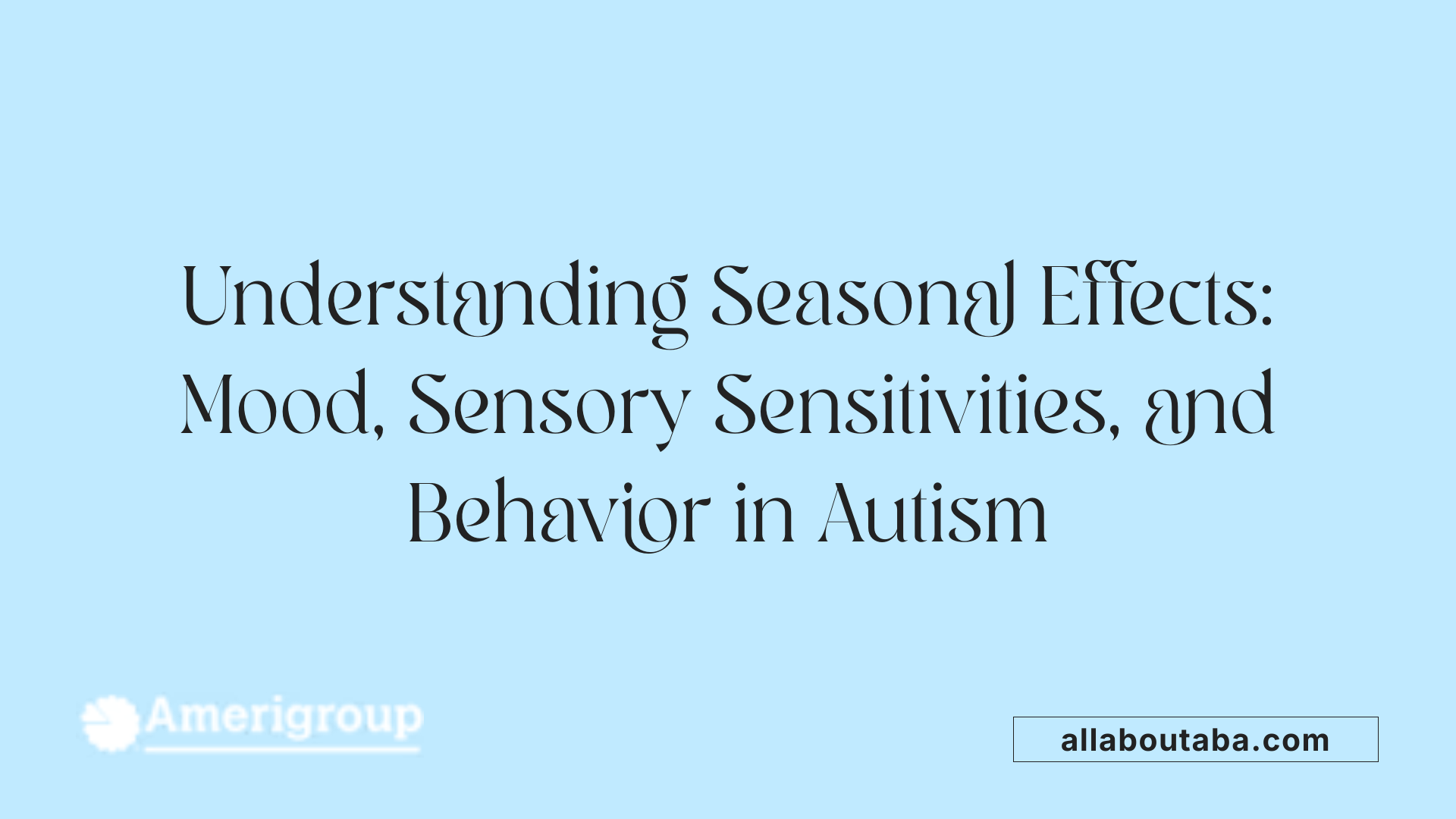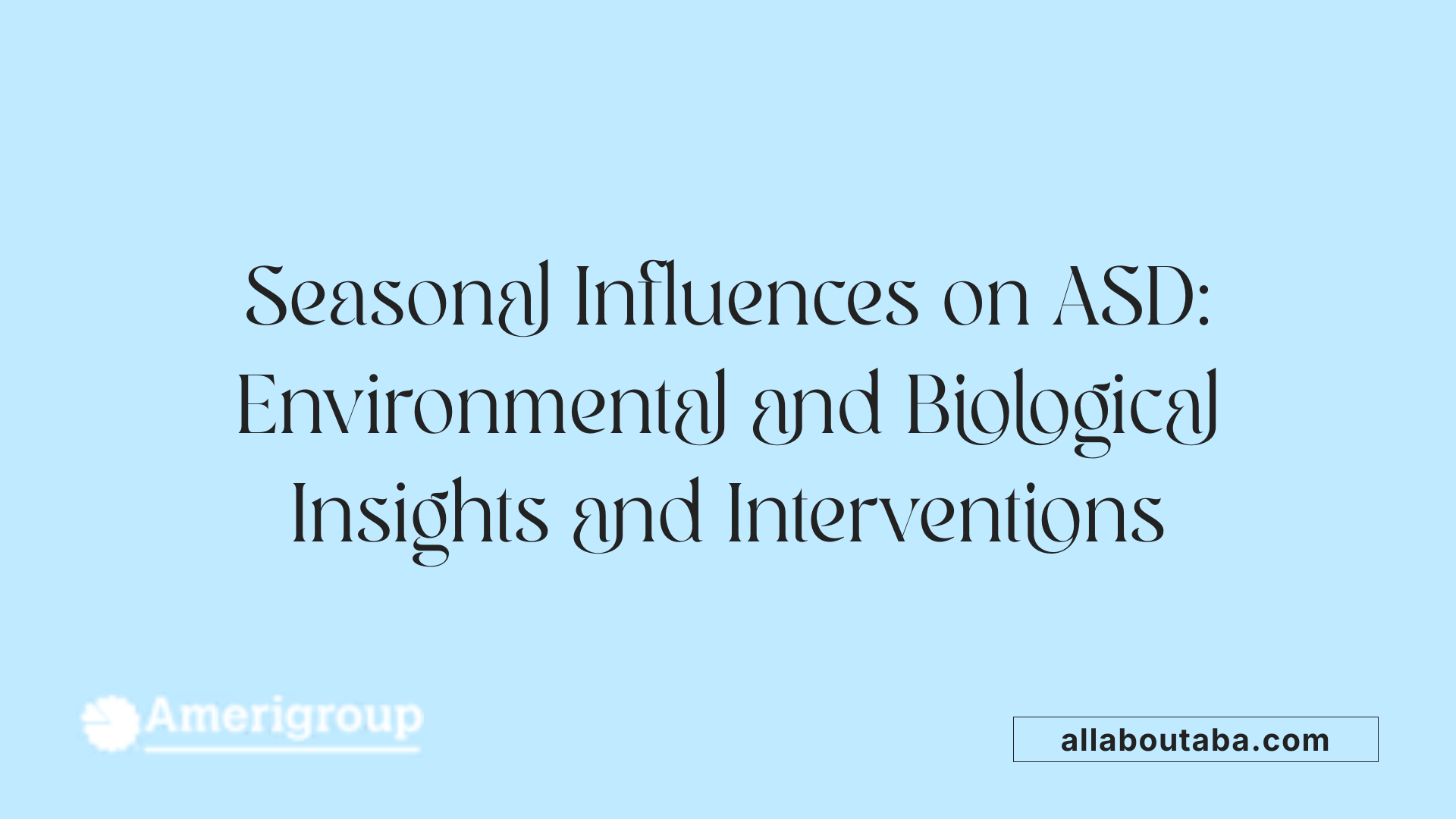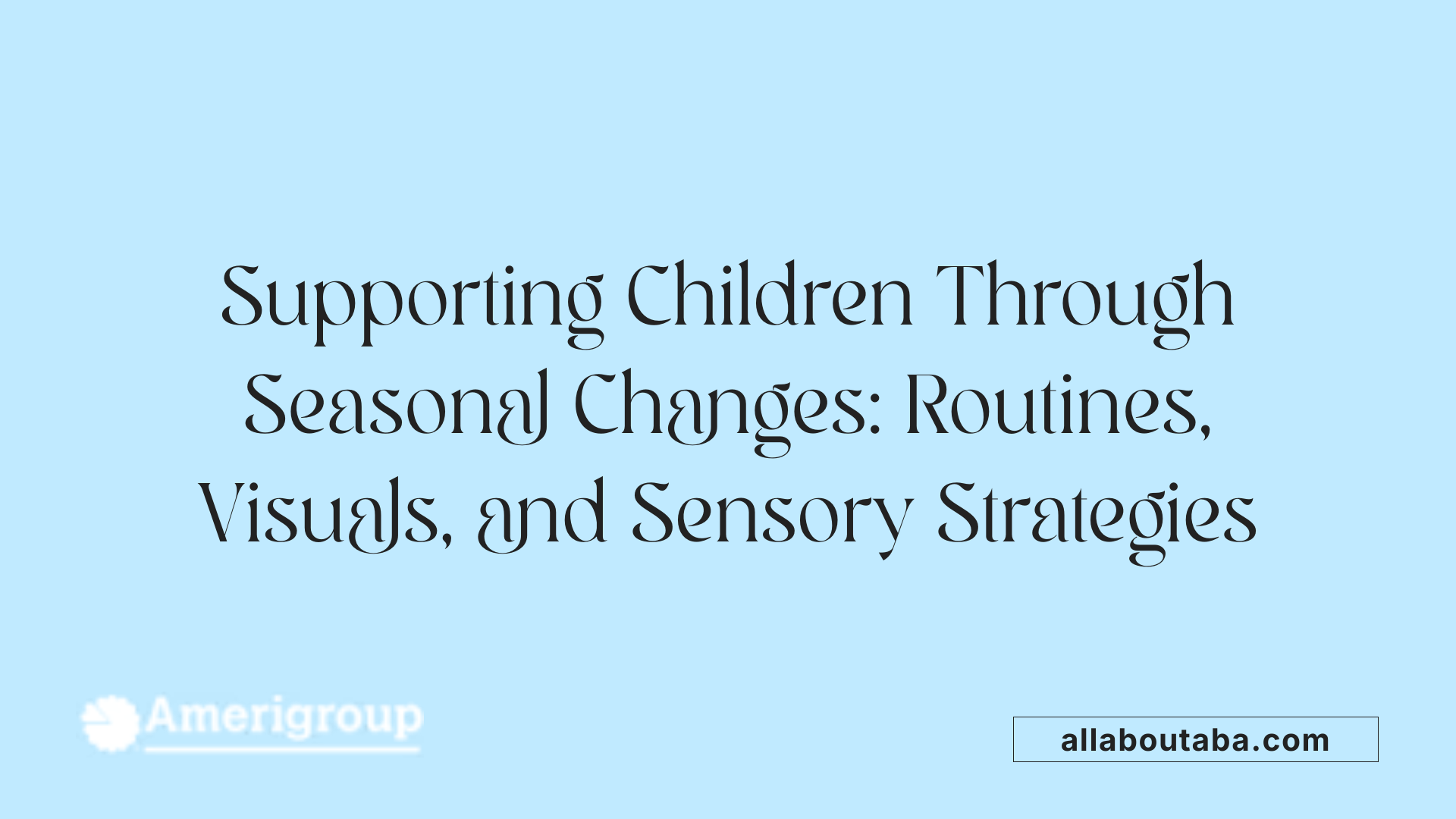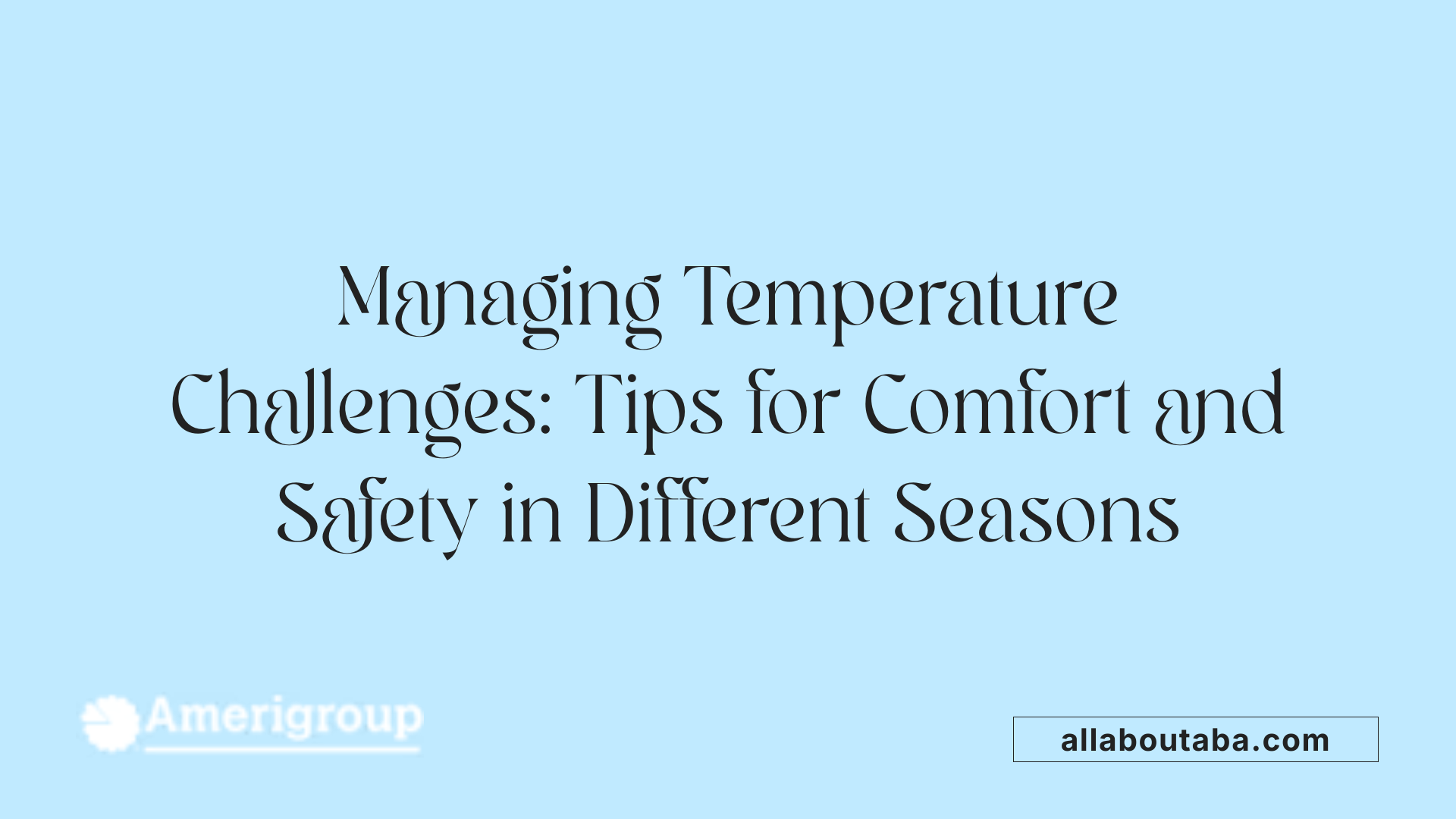Autism And The Impact Of Seasonal Changes On Behavior
Understanding the Interplay Between Seasons and Autism
Seasonal changes profoundly influence the behavior, mood, and sensory experiences of individuals with autism. Recognizing how environmental factors such as light, temperature, and routine disruptions interact with the neurological and sensory sensitivities inherent in autism can help caregivers and clinicians develop effective strategies to promote stability and well-being throughout the year.
Impact of Seasonal Changes on Behavior and Symptoms in Autism

How do seasonal changes impact behaviors and symptoms in individuals with autism?
Seasonal shifts throughout the year can have profound effects on individuals with autism, influencing their mood, behavior, and sensory sensitivities. During the colder, darker winter months, many autistic individuals experience an increase in feelings of depression or irritability, partly due to seasonal affective disorder (SAD). Reduced exposure to natural light can disrupt serotonin and melatonin balance, which are crucial for mood regulation and sleep patterns. This often manifests as heightened feelings of sadness, fatigue, and irritability.
In contrast, the summer months, with their increased light, warmth, and social activity, can be overstimulating for some autistic individuals. Bright environments, elevated noise levels, and social demands might lead to feelings of anxiety or sensory overload. These conditions can cause behavioral challenges such as meltdowns, withdrawal, or difficulties in maintaining routines.
Environmental factors associated with seasonality—like changes in temperature, light exposure, and holiday-related stimuli—amplify sensory sensitivities and make routine adherence more challenging. For example, abrupt changes in clothing, outdoor activities, or sleep schedules can increase stress, anxiety, and behavioral disruptions.
Understanding the influence of seasons on autism symptoms enables caregivers and healthcare providers to implement strategies aimed at reducing these adverse effects. Tailored interventions such as light therapy, maintaining consistent routines, and sensory accommodations can help autistic individuals adapt better to seasonal transitions.
Effects of reduced sunlight during winter on mood and irritability
Winter’s lower sunlight levels are closely linked with increased depressive symptoms in many autistic individuals due to decreased serotonin production. This reduction can lead to symptoms like irritability, withdrawal, and decreased motivation. Behavioral signs can include increased meltdowns, sleep disturbances, and decreased participation in daily activities.
Overstimulation and routine disruptions during summer
Summer can bring about overstimulation due to longer daylight hours, social gatherings, and holiday festivities. These environments often challenge autistic individuals' needs for predictability and sensory regulation. The disruption of routines, combined with changes in temperature and outdoor stimuli, can increase anxiety levels and behavioral difficulties.
Sensory sensitivities amplified by seasonal environment changes
Temperature fluctuations and changes in light can heighten sensory sensitivities. Children and adults with autism often experience intensified reactions to sensory inputs like heat, cold, bright lights, or loud noises during specific seasons. These amplified sensitivities may cause withdrawal, discomfort, or aggressive behaviors.
Strategies for mitigation, including light therapy and routine management
To counteract seasonal impacts, several strategies can be employed. Light therapy using specialized lightboxes helps simulate natural sunlight, which can help improve serotonin levels and stabilize mood and sleep cycles. Care must be taken, especially for individuals with high energy levels, to avoid triggering manic episodes.
Maintaining regular routines and predictable schedules remains crucial. Using visual supports, social stories, and gradual adjustments helps ease transitions during seasonal changes. Additionally, managing sensory input through controlled lighting, temperature regulation, and soothing activities supports emotional and behavioral stability.
Other approaches include ensuring adequate intake of vitamin D through diet or supplements, promoting physical activity, and engaging in stress management techniques. These holistic strategies, combined with professional guidance, can significantly improve quality of life for autistic individuals experiencing seasonal variations.
The Relationship Between Seasonal Changes and Autism Spectrum Disorder (ASD): Environmental and Biological Factors

What is the relationship between seasonal changes and autism spectrum disorder (ASD), and what mechanisms or environmental factors are involved?
Seasonal shifts play a notable role in affecting individuals with autism spectrum disorder (ASD). These changes, particularly during fall and winter, can intensify existing behavioral and sensory challenges associated with autism. This is largely due to decreased natural light, temperature variations, and disruptions in routines that are vital for individuals with autism.
Environmental factors linked to seasonal variation include a decline in sunlight exposure, which impacts vitamin D production and circadian rhythm regulation. Reduced sunlight has been correlated with higher rates of vitamin D deficiency in pregnant women, a factor associated with increased ASD risk in offspring. Additionally, viral infections more common in winter, such as rubella or cytomegalovirus, can influence fetal brain development if exposure occurs during pregnancy.
Pollutants and toxins like pesticides and air pollution tend to spike in urban and industrial areas during certain seasons, potentially contributing to ASD development through environmental stressors. The complex interaction between these environmental influences and genetic susceptibility underscores the multifaceted nature of ASD's etiology.
Biologically, seasonal changes disrupt circadian rhythms, affecting the sleep-wake cycle due to alterations in melatonin levels. This hormone, regulated by light exposure, influences sleep quality and mood. Fluctuations in serotonin, another neurotransmitter affected by daylight, can also lead to mood swings, irritability, and anxiety among autistic individuals.
Many with autism also suffer from co-occurring conditions like Seasonal Affective Disorder (SAD), characterized by depression linked to reduced sunlight. SAD can be particularly distressing for those with autism, who often prefer routines and predictable environments. Changes in routine, clothing, temperature, and social expectations during fall and winter further exacerbate feelings of discomfort and anxiety.
Understanding these influences helps in managing ASD symptoms during off-seasons. Strategies such as light therapy using lightboxes to mimic natural light are effective in regulating melatonin and serotonin levels, improving mood and sleep. Maintaining consistent routines, pre-planning for seasonal changes, and ensuring adequate vitamin D intake are also recommended.
In summary, seasonal changes influence ASD through both environmental factors — like light, temperature, and pollutants — and biological processes involving hormonal regulation and circadian rhythms. Recognizing these influences allows for targeted interventions that support emotional stability and routine adherence during seasonal transitions.
| Aspect | Impact | Additional Notes |
|---|---|---|
| Sunlight exposure | Affects vitamin D synthesis, circadian rhythms, serotonin, melatonin | Reduced sunlight linked with increased ASD risk and mood issues |
| Viral infections | Maternal infections in winter during pregnancy | Associated with higher ASD incidence |
| Pollution and toxins | Increased exposure in urban areas | May contribute to neurodevelopmental risks |
| Hormonal fluctuations | Changes in serotonin and melatonin | Impact mood, sleep, behavior |
| Routine disruptions | Changes during holidays, weather | Increase anxiety and behavioral issues |
| Management strategies | Use of light therapy, routine stability | Help mitigate seasonal effects on ASD |
Understanding the interplay between environmental factors and biological mechanisms related to seasonality provides a comprehensive view of how seasons can influence ASD characteristics. Tailored interventions during vulnerable periods can greatly improve quality of life for individuals with autism.
Seasonal Affective Disorder (SAD) and Autism: Challenges and Management Strategies

How does seasonal affective disorder affect individuals with autism, and what strategies can help manage it?
People with autism are more prone to experiencing Seasonal Affective Disorder (SAD), a form of depression that occurs during fall and winter months, when daylight hours are shorter. This heightened vulnerability stems from their sensory sensitivities and difficulties in regulating emotions. During seasonal shifts, autistic individuals may face increased mood swings, depression, and irritability.
SAD influences several aspects of daily life for autistic individuals, including mood, sleep patterns, energy levels, and behavior. They might show signs like withdrawal, reduced participation in activities, or behavioral shifts such as increased meltdowns or frustration. These changes can be challenging for caregivers and support networks to manage.
In addition to winter SAD, some autistic individuals experience a form called
Transitions and Routine Disruptions: Supporting Children with Autism

How do seasonal transitions influence behavior in children with autism, and what interventions support their adjustment?
Seasonal changes can have a profound impact on children with autism, often leading to increased behavioral challenges. As the environment shifts with shorter days, colder weather, and holiday festivities, children may experience difficulty maintaining their routines and managing sensory input.
These disruptions can cause heightened anxiety, mood swings, irritability, and difficulty sleeping. For example, changes in light and temperature can interfere with their circadian rhythms and melatonin production, affecting sleep quality and mood stability.
To support children during these times, tailored interventions play a crucial role. Visual supports like social stories and schedules help prepare children for upcoming seasonal changes, reducing feelings of uncertainty and anxiety. Gradually introducing new routines and clothing adapted to the season assists children in adjusting slowly and comfortably.
Maintaining a sensory-friendly environment is vital—reducing overwhelming stimuli from holiday decorations, crowds, and loud sounds can lessen sensory overload.
Involving children in planning activities related to the season, such as selecting outdoor clothing or participating in festive preparations, can empower them and lessen resistance.
Collaborating with therapists, behavior analysts, and educators ensures a coordinated approach. These professionals can offer strategies to modify routines and environments, address sensory needs, and promote consistent sleep schedules.
Proactive planning—anticipating disruptions and having backup indoor activities, social stories, and visual aids ready—helps children adapt more smoothly to seasonal transitions.
Interventions Using Visual Supports, Social Stories, and Gradual Adjustments
Visual aids are essential tools for children with autism, providing clarity and predictability. Social stories depict upcoming changes or new routines in a simple, engaging way, easing anxiety about unfamiliar or daunting circumstances.
Gradual adjustments, such as slowly introducing new clothing or slowly increasing outdoor time, help children adapt without feeling overwhelmed. Consistent routines, even during holidays or school breaks, contribute to stability and a sense of security.
Using visual schedules for daily activities reassures children about what to expect, reducing stress caused by unpredictability.
Addressing Sensory Needs and Holiday Overload
Holiday seasons often introduce sensory overload due to lights, sounds, and crowds. Preparing children by practicing sensory activities, using noise-canceling headphones, and creating quiet spaces can help.
Recognizing signs of sensory overload—like increased meltdowns or withdrawal—allows caregivers to implement calming strategies promptly.
Balancing festive activities with sensory considerations prevents overload while still allowing children to enjoy seasonal celebrations.
Collaborating with Therapy Teams and Proactive Planning
Engaging with occupational therapists, speech-language pathologists, and behavior analysts ensures personalized support plans. These experts can suggest sensory accommodations, behavioral strategies, and routines tailored to individual needs.
Pre-planning is vital. Arranging activities, materials, and accommodations in advance helps minimize unexpected stressors.
Regular communication among caregivers, educators, and therapists fosters consistency across environments.
In summary, supporting children with autism through seasonal transitions requires a combination of visual supports, sensory accommodations, routine maintenance, and professional collaboration. These strategies help mitigate behavioral difficulties and promote a smoother adjustment, allowing children to navigate seasonal changes with greater confidence and comfort.
Temperature Regulation Challenges in Autism: Environmental and Behavioral Strategies

What are the effects of temperature regulation challenges in individuals with autism related to seasonal variations, and how can they be managed?
People with autism often experience unique difficulties in regulating their body temperature, which can be worsened during seasonal changes. These challenges are largely linked to differences in sensory processing, the autonomic nervous system, and how their brains perceive thermal stimuli.
Many autistic individuals are hypersensitive to heat or cold, meaning they may feel discomfort even in temperatures that others find comfortable. For example, a child might refuse to wear certain types of clothing because of tactile sensitivities or avoid outdoor activities in extreme weather, leading to social isolation or discomfort.
On the other hand, some individuals may have a decreased ability to perceive temperature changes — a condition called hyposensitivity — which can increase safety risks such as hyperthermia (overheating) or hypothermia (getting too cold). For instance, they might not realize they are too cold or too hot, which can be dangerous without proper monitoring.
These temperature regulation issues can be further impacted by seasonal variations, with colder months increasing the risk of cold exposure and summer months raising concerns about heat exhaustion. Managing these challenges involves multiple strategies:
- Environmental controls: Keeping living and learning spaces climate-controlled helps maintain a stable temperature.
- Appropriate clothing: Using layered clothing or thermal wear can help manage sensitivity to temperature extremes.
- Hydration and cooling: Ensuring adequate fluid intake and using cooling devices or fans during hot weather are crucial.
- Monitoring and education: Teaching individuals to recognize signs of temperature distress, and regularly checking their body temperature, supports safety.
Understanding each individual's specific sensitivities is vital. Some might need extra supervision during seasonal transitions, while others benefit from visual aids or social stories that explain temperature changes.
Overall, tailored environmental modifications combined with education and behavioral support significantly improve comfort and safety for autistic individuals across seasons. By recognizing and addressing these temperature regulation challenges, caregivers and educators can create safer, more accommodating environments that respect each person's sensory profile.
Supporting Well-being Across Seasons
Understanding the complex ways in which seasonal changes influence individuals with autism is essential for fostering adaptive support strategies. By addressing environmental sensitivities, routine disruptions, sleep, mood fluctuations, and sensory needs, caregivers and clinicians can help mitigate behavioral disturbances and promote emotional stability. Adapting interventions—such as light therapy, visual supports, sensory accommodations, and proactive planning—can make a significant difference in improving quality of life. As awareness grows about the impact of seasonal transitions, ongoing research and individualized approaches will be key to ensuring that individuals with autism navigate the changing seasons with resilience and comfort.
References
- Autism and Seasonal Affective Disorder
- Environmental Influences on Individuals with Autistic ...
- What does autism with seasonal affective disorder look like?
- Helping Children with Autism Navigate Seasonal Changes
- Help Your Child Prepare for Seasonal Changes
- The Link Between Autism and Temperature Regulation
- Helping Children with Autism Navigate Seasonal Changes
- Seasonal fluctuations in problem behaviors among young ...
- Seasonal Changes For Children With Autism
Other articles
Recent articles

Best Practices For Autism-Friendly Fitness And Recreation Centers

Best Ways To Promote Healthy Social Media Use For Autistic Teens

How To Help Autistic Children Cope With Public Speaking

Autism And Strategies For Managing Unexpected Changes

Best Podcasts About Autism For Parents And Educators

Autism And The Impact Of Seasonal Changes On Behavior

The Role Of Diet In Managing Co-Occurring Conditions With Autism

Sleep Challenges In Autism And Practical Solutions

Best Ways To Build Daily Routines For Autistic Children

Best Practices For Supporting Autistic Entrepreneurs

Autism And Strategies For Navigating Large Social Gatherings

Adaptive Sports And Recreational Activities For People With Autism

Autism And The Benefits Of Story-Based Learning Activities

Understanding The Role Of Play In Autism Development

Autism And The Impact Of Environmental Noise On Learning

How To Create Autism-Friendly Community Spaces

Autism And Chronic Health Conditions: What To Know

The Role Of Care Managers In Autism Life Planning

How To Teach Social Boundaries To Autistic Children

How Autistic Individuals Experience Empathy Differently

How To Support Autistic Employees In Remote Work Settings

Autism And The Relationship Between Motor Skills And Learning

How To Create Community Resource Guides For Autism Families

How To Teach Daily Living Skills To Autistic Teens

Autism And The Impact Of Mind-Body Practices On Stress Reduction

Autism And The Benefits Of Outdoor Group Activities

How To Create Autism-Friendly Sensory Paths In Schools

Best Practices For Autism-Friendly Park And Recreation Areas

Autism And Strategies For Reducing School Refusal

Supporting Autistic Individuals In Public Speaking

The Role Of Diet In Managing Autism Symptoms

The Benefits Of Gardening Clubs For Autism Social Development

How To Prepare Autistic Children For Dental Visits

Autism And Employment: Career Paths That Work

Best Practices For Autism-Friendly Hotels And Lodging

The Impact Of Screen Time On Autism Development

Autism Screening Tools For Early Childhood

The Role Of Physical Exercise In Autism Therapy

Best Strategies For Supporting Autistic College Students

The Role Of Technology In Autism Early Detection

Sensory-Friendly Classroom Design Ideas For Autistic Students

The Role Of Speech Therapy In Building Social Communication Skills

Best Strategies For Handling Autistic Burnout In Adults

Autism And The Importance Of Predictability In Routine

Autism And Peer Education: Teaching Acceptance In Schools

Best Practices For Sensory-Friendly Libraries And Reading Rooms

Self-Advocacy Skills For Autistic Adults

The Role Of Technology In Autism Peer Communication

Promoting Physical Activity In Children With Autism

How To Prepare Autistic Children For Medical Procedures

The Role Of Social Media In Autism Advocacy And Awareness

The Impact Of Sensory Rooms In Public Facilities For Autism

How To Create An Autism-Friendly Holiday Celebration

Best Practices For Inclusive Education For Autistic Students

Autism And Mental Health: Recognizing Signs Of Distress

Best Practices For Sensory-Friendly Waiting Rooms

The Role Of Teachers In Early Autism Red Flag Identification

Autism-Friendly Housing Design Features

Autism-Friendly Housing Design Features

How Environmental Modifications Improve Autism Outcomes

Autism And Technology-Based Learning Tools

Supporting Autistic Children Through Changes In Routine

The Link Between Autism And Working Memory Challenges

Best Practices For Autism-Friendly Cooking Classes

Autism And The Benefits Of Structured Music Lessons

Best Books To Teach Kids About Autism Acceptance

Sensory Diets And Their Benefits For Autism Management

How To Prepare Autistic Teens For Driver’s Education

How To Teach Autistic Teens About Healthy Relationships

The Role Of Visual Prompts In Building Daily Habits For Autism

Addressing Sleep Regression In Children With Autism

Understanding Social Stories And How They Help Autistic Children

Navigating Insurance Coverage For Autism Therapy Services

How To Prepare Autistic Adults For Independent Travel

Supporting Autistic Individuals In Volunteer Work

How Mindfulness Practices Can Support Autism Well-Being

Understanding Hyperfocus And Special Interests In Autism

Understanding Stimming As A Self-Regulation Tool

Sensory-Based Interventions For Autism At Home

Best Ways To Introduce Self-Advocacy In Autistic Teens

Best Ways To Support Autistic Employees In Customer Service Roles

Best Practices For Autism-Friendly Volunteer Programs

Autism And The Benefits Of Sensory Play For Emotional Growth

Autism And Strategies For Building Peer Relationships

Understanding How Autism Affects Memory Processing

Autism And Strategies For Building Coping Skills In Teens

The Role Of Parent Training In Autism Intervention Programs

Autism-Friendly Workplace Accommodations

Using Visual Timers For Autism Time Management

What Is ABA Therapy?

Autism and Sleep

Do Plastic Toys Cause Autism?

Autism Facial Expressions

Autism and Motor Skills

Which Parent Carries The Autism Gene?

Autism Symbols & Colors

Rett Syndrome: Symptoms, Causes, and Treatment

Self-Diagnosed Autism

Autism and Sound Sensitivity

Autism With Speech Delay
We’re All About You, Your Family, and Your Child

